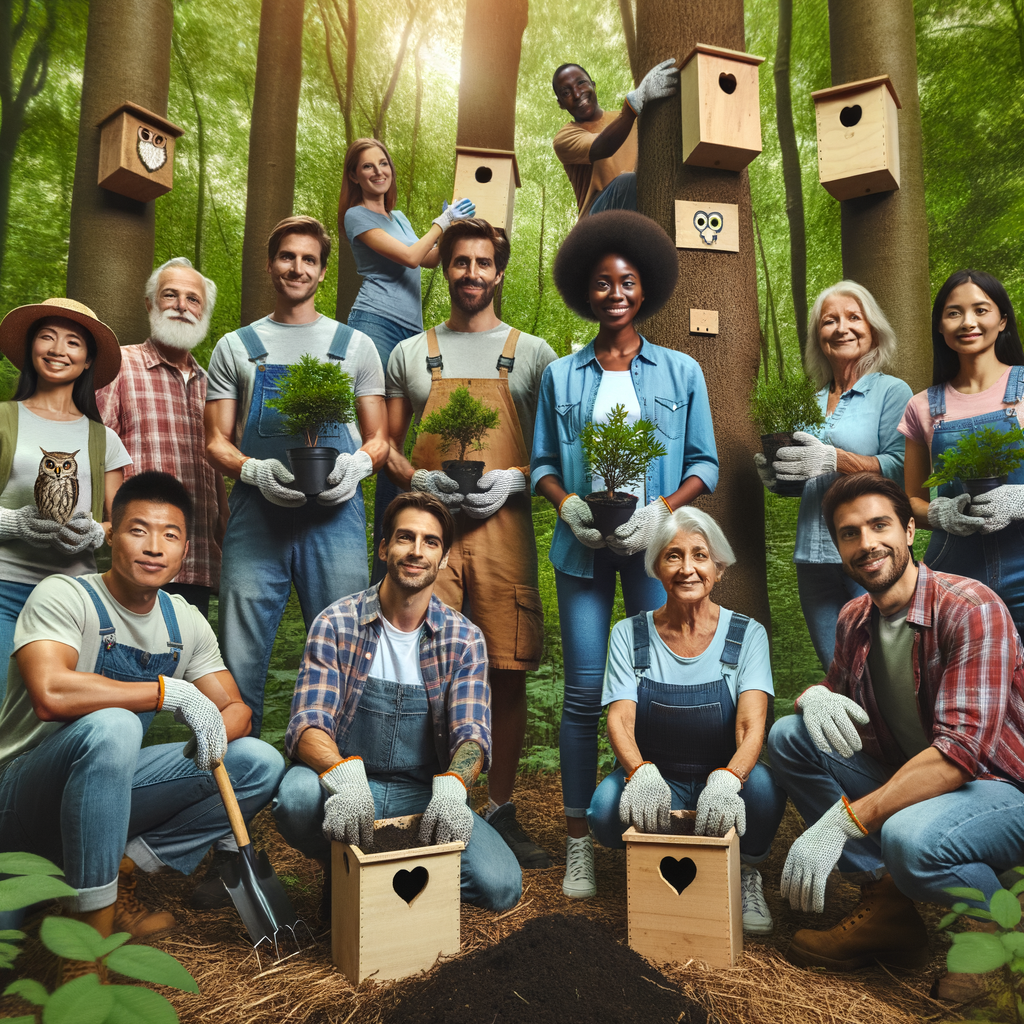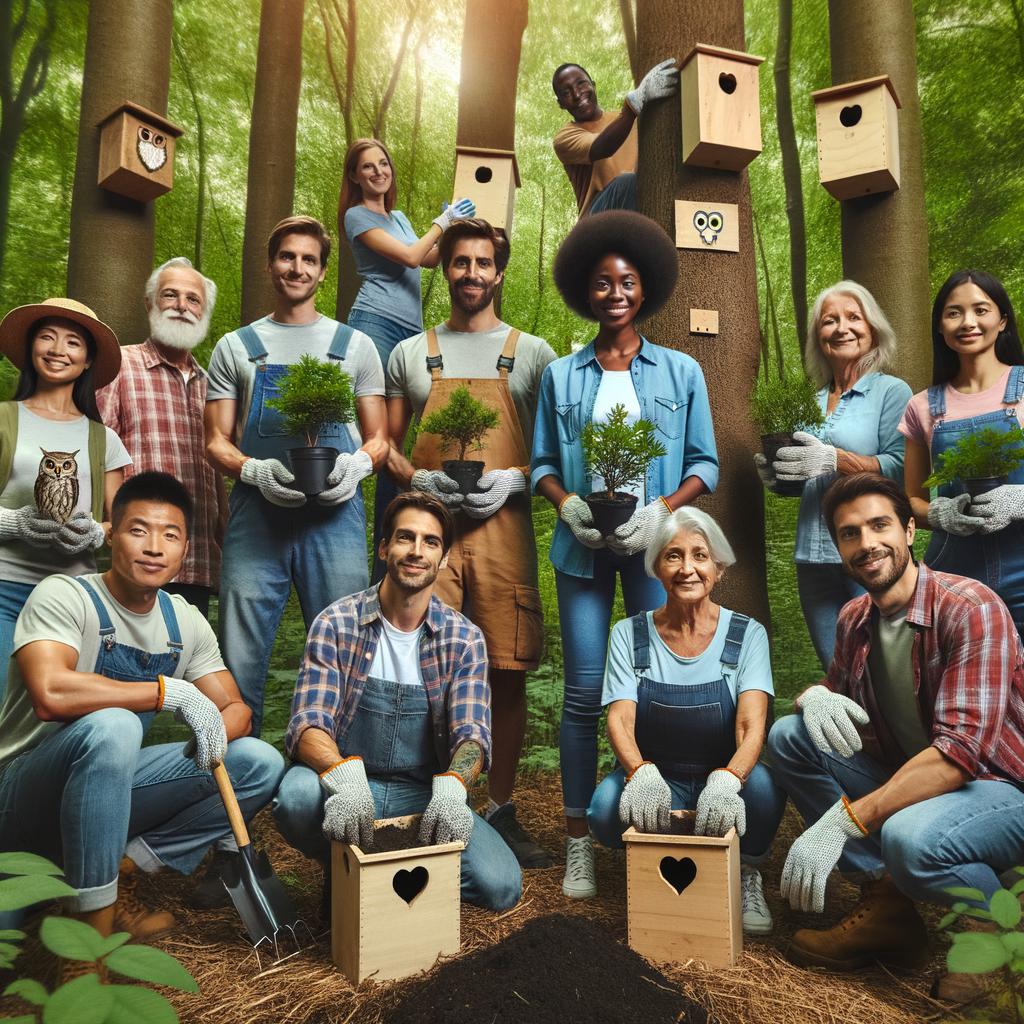
Introduction to Local Owl Conservation
They help control the population of small animals, like rodents, which can be pests. However, many local owl species are facing challenges that threaten their survival.
- Importance of owl conservation: They help keep the balance of nature by controlling the population of small mammals. Without owls, there could be an increase in pests, which can affect crops and spread diseases.
- Current state of local owl populations: Many local owl species are declining in numbers. This is due to habitat loss, pollution, and climate change. For example, the Barn Owl is one species that has seen a decrease in population in some areas. Conservation efforts are needed to protect these beautiful birds and ensure they thrive for future generations.
| Owl Species | Population Status |
|---|---|
| Barn Owl | Declining |
| Great Horned Owl | Stable |
| Snowy Owl | Vulnerable |
Understanding Owl Habitat Protection
Key Elements of Owl Habitats
- Forest density: These areas provide cover and safety from predators. Dense forests also help owls hunt more effectively.
- Prey availability: They mainly eat small mammals, birds, and insects. A habitat rich in prey ensures owls can find enough to eat.
- Nesting sites: They often use tree cavities, old nests of other birds, or even man-made structures. Good nesting sites are crucial for raising their young.
Threats to Owl Habitats
- DeforestationWhen trees are cut down, owls lose their homes. Forests provide shelter and food for owls. Without trees, owls struggle to survive. According to the Wikipedia, deforestation affects many species, not just owls.
- UrbanizationMeans building more cities and towns. This takes away land from owls. As cities grow, natural areas shrink. Owls find it hard to live in noisy, busy places. They need quiet forests to hunt and nest. Urbanization is a growing problem for wildlife everywhere.
- Climate ChangeChanges in weather can alter forests and food supplies. Some areas may become too hot or too cold for owls. According to Wikipedia, climate change impacts many animals, including owls. Protecting our environment helps protect owl habitats.
Supporting Owl Conservation Programs
Donating to Owl Conservation Programs
- How donations help: Donations play a crucial role in owl conservation. They fund research, habitat protection, and rescue efforts. For example, donations can help buy land to create safe habitats for owls. They also support educational programs that teach people about the importance of owls in our ecosystem.
-
Reliable owl conservation programs to consider:
- The Owl Trust: This organization focuses on protecting owl species and their habitats. They use donations to fund rescue operations and educational outreach.
- Owl Research Institute: Known for its scientific research on owls, this institute uses donations to study owl behavior and habitat needs.
- World Wildlife Fund (WWF): While not solely focused on owls, WWF supports many projects that help owl conservation. Donations help fund global efforts to protect wildlife.
Volunteering for Owl Conservation
-
Benefits of Volunteering
It helps protect these amazing birds and their habitats. You can learn a lot about owls and nature. Volunteering also allows you to meet new people who care about wildlife. Plus, it feels great to know you are making a difference!
-
-
- Learn about owls: You will get to know different owl species and their habits.
- Help the environment: Your work helps keep owl habitats safe and clean.
- Meet like-minded people: Connect with others who love nature and wildlife.
- Feel good: Volunteering gives you a sense of accomplishment and joy.
-
-
How to Get Involved
Getting involved in owl conservation is easy. Here are some steps to help you start:
-
-
- Find a local group: Look for owl conservation groups in your area. You can search online or ask at local nature centers.
- Attend a meeting: Join a meeting or event to learn more about their work and how you can help.
- Sign up to volunteer: Many groups have sign-up sheets or online forms. Fill one out to start volunteering.
- Get training: Some tasks may need special training. Be sure to attend any training sessions offered.
- Start helping: Once you are trained, you can start helping with projects like habitat clean-ups, owl monitoring, and more.
-
Here is a table with some key information:
| Step | Action |
|---|---|
| 1 | Find a local group |
| 2 | Attend a meeting |
| 3 | Sign up to volunteer |
| 4 | Get training |
| 5 | Start helping |
Volunteering for owl conservation is a rewarding experience. You can make a real impact on the lives of these beautiful birds. Start today and see the difference you can make!
Community Owl Conservation Initiatives
Starting a Community Owl Conservation Initiative
Starting a community owl conservation initiative can make a big difference. Here are some steps to help you get started and a case study to inspire you.
-
- Steps to start an initiative
1. Research: Learn about the owls in your area. Understand their habitat, diet, and threats. You can find useful information on Wikipedia.
2. Form a Team: Gather like-minded people. It’s easier and more fun to work together.
3. Set Goals: Decide what you want to achieve. It could be building owl boxes or protecting their habitats.
4. Plan Activities: Plan events like clean-up drives, educational workshops, and fundraisers.
5. Get Support: Reach out to local authorities, schools, and businesses for support.
6. Spread the Word: Use social media, posters, and community meetings to raise awareness.
-
- Case study: Successful community owl conservation initiatives
In a small town in Oregon, a group of students started an owl conservation initiative. They built 50 owl boxes and placed them in local parks. Within a year, the owl population increased by 20%. This success story shows that even small efforts can make a big impact.
| Step | Description |
|---|---|
| Research | Learn about local owls and their needs. |
| Form a Team | Gather people who share your passion. |
| Set Goals | Decide on specific objectives for your initiative. |
| Plan Activities | Organize events and actions to help owls. |
| Get Support | Seek help from local authorities and businesses. |
| Spread the Word | Raise awareness through various channels. |
Supporting Existing Community Initiatives
-
How to Find Local Initiatives
Finding local initiatives to support owl conservation can be easy. Here are some ways:
- Local Nature Centers: Visit your nearest nature center. They often have information on local conservation projects.
- Community Bulletins: Check community boards at libraries or community centers for announcements.
- Online Searches: Use search engines to find local groups dedicated to owl conservation.
- Social Media: Join local wildlife groups on social media platforms to stay updated.
-
Ways to Support
There are many ways you can support these initiatives:
- Volunteer: Offer your time to help with activities like habitat clean-ups or educational events.
- Donate: Financial contributions can help fund research and conservation efforts.
- Spread the Word: Share information about the initiative with friends and family.
- Attend Events: Participate in local events to show your support and learn more.
Owl Preservation Initiatives
Owl Preservation
-
What is owl preservation?
This helps ensure that owls can live and thrive in the wild. It involves actions like saving forests, reducing pollution, and stopping illegal hunting.
-
Why is it important?
- Balance in Nature: Owls help control the population of small animals like mice and insects. This keeps the ecosystem balanced.
- Indicator Species: Owls are often called “indicator species.” This means their health shows how healthy the environment is. If owls are doing well, it usually means the environment is healthy.
- Educational Value: Owls are fascinating creatures. Learning about them can teach us a lot about nature and conservation.
Supporting Owl Preservation Initiatives
-
How to Support
There are many ways you can help with owl preservation. Here are some ideas:
- Donate: Many organizations need funds to continue their work. You can donate to groups like the Audubon Society.
- Volunteer: Give your time to local conservation projects. This can include helping with habitat restoration or educational programs.
- Spread Awareness: Share information about owls and their importance. Use social media or talk to friends and family.
- Adopt an Owl: Some organizations offer owl adoption programs. Your support helps care for injured or orphaned owls.
By taking these steps, you can make a big difference in owl conservation efforts.
-
Key Takeaways
- Supporting owl preservation can be done through donations, volunteering, spreading awareness, and adopting owls.
- Every small action helps in protecting these important birds.
- Getting involved in local initiatives can have a significant impact on owl populations.
Protecting Local Owls: Practical Tips
-
Creating Owl-Friendly Spaces
You can help by making your yard owl-friendly. Plant native trees and shrubs. These provide shelter and food for owls. Also, leave some dead trees standing. Owls often nest in them.
Another idea is to put up owl boxes. These are like birdhouses but for owls. You can buy them or make your own. Place them high up in trees to keep owls safe from predators.
-
Reducing Threats to Owls
One big threat is poison. People use poison to kill rats, but it can also hurt owls. Instead, use traps or other safe methods to control pests.
Cars are another danger. Owls often hunt near roads. Drive carefully, especially at night. Slow down if you see an owl.
Power lines can also be a problem. Owls can get shocked if they touch them. Some places are making power lines safer for birds. You can support these efforts in your community.
-
Spreading Awareness
Share what you know with friends and family. You can also talk to your school or community group about owls.
Join or support local wildlife groups. They often have events and programs to help owls. You can volunteer or donate to these groups.
Use social media to spread the word. Post pictures and facts about owls. Encourage others to protect these amazing birds.
Conclusion: The Impact of Owl Conservation
Owl conservation is very important for our environment. Owls play a key role in keeping nature balanced. By protecting them, we help many other animals and plants too.
-
Benefits of Owl Conservation
- Healthy Ecosystems: Owls control the population of small animals like mice and insects. This helps keep the ecosystem balanced.
- Biodiversity: Protecting owls also protects other species that share their habitat.
- Education and Awareness: Conservation efforts teach people about the importance of wildlife and nature.
-
Future of Owl Conservation
- Community Involvement: More people are joining conservation programs. This helps spread the word and get more support.
- Technology: New tools and technology are helping us track and protect owls better.
- Policy Changes: Governments are making new laws to protect owl habitats.
Owl conservation has many benefits. It helps keep our environment healthy and teaches us about the importance of nature. The future looks bright with more people and new technologies joining the cause. Together, we can make a big difference for owls and our planet.
| Benefit | Impact |
|---|---|
| Healthy Ecosystems | Controls small animal populations |
| Biodiversity | Protects various species |
| Education | Raises awareness |
| Community Involvement | Increases support |
| Technology | Improves tracking and protection |
| Policy Changes | Strengthens habitat protection |






